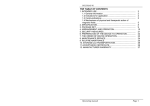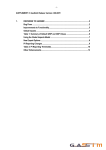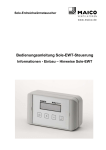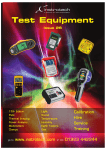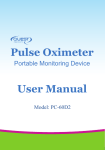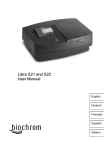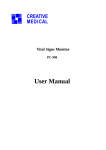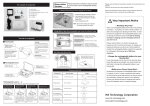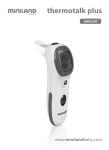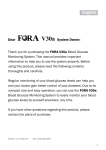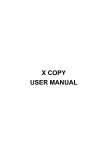Download PC – 300 Series
Transcript
Spot-Check Monitor User Manual User Manual for Spot-Check Monitor This Manual is written for the current Spot-Check Monitor. The Manual describes, in accordance with the Spot-Check Monitor’s features and requirements, main structure, functions, specifications, correct methods for transportation, installation, usage, operation, repair, maintenance and storage, etc. as well as the safety procedures to protect both the user and equipment. Refer to the respective chapters for details. The Manual is published in English and we have the ultimate right to explain the Manual. Version of This User Manual: Ver1.3 Issue Date: January 27th 2015 Software version: All rights reserved. Marks in the Manual: 0 Caution: must be followed to avoid endangering the operator and the patient. Attention: must be followed to avoid causing damage to the Spot-Check monitor. ☞ Note: contains some important information and tips about operations and application. 3502-2600002 I User Manual for Spot-Check Monitor Instruction to User Dear Customers, Thank you for purchasing this quality product. Please read the following information very carefully before using this device. Read these instructions carefully before using this Spot-Check Monitor. These instructions describe the operating procedures to be followed strictly. Failure to follow these instructions can cause monitoring abnormity, equipment damage and personal injury. The manufacturer is NOT responsible for the safety, reliability and performance issues and any monitoring abnormality, personal injury and equipment damage due to user's negligence of the operation instructions. The manufacturer's warranty service does not cover such faults. Warnings: 0 Do NOT use the device under the flammable gas condition or in any environment that may lead to explosion. 0 The device and accessories that shall not be serviced or maintained while the device is in use. 0 The doctor or patient is an intended operator. 0 Do not modify this equipment without authorization of the manufacturer. II User Manual for Spot-Check Monitor 0 The SpO2, NIBP, Temperature, ECG(optional) measurements are frequently used functions. 0 The device is IP22 with protection harmful solid objects and ingress of liquid. So that means the device is protected against solid foreign objects of 12.5mm and greater, and protected against vertically falling water drops when enclosure tilted up to 15。 0 Please check the monitor completely to verify that the accessories can function safely and normally. 0 When the user is connected with other devices, the total leakage current may exceed the limitation and cause potential danger to the user as a result. 0 All combinations of equipment must be in compliance with standard of IEC 60601-1-1 medical and electric system requirements. 0 Although biocompatibility tests have been performed on all the applied parts, some exceptional allergic patients may still have anaphylaxis. Do NOT apply to those who have anaphylaxis. 0 All the connecting cables and rubber tubes of the applied parts should be kept away from the patient’ neck to prevent any possible suffocation of the patient. 0 All the parts of the monitor should NOT be replaced at will. If necessary, please use the components provided by the manufacturer or those that are of the same model and III User Manual for Spot-Check Monitor specifications as the accessories along with the monitor which are provided by the same factory, otherwise, negative effects concerning safety and biocompatibility etc. may be caused. 0 If the monitor falls off accidentally, please do NOT operate it before its safety and technical performance have been tested minutely and positive testing results obtained. 0 Do NOT open the device cover without authorization. The cover should only be opened by qualified service personnel. 0 When disposing of the monitor and its accessories, the local law should be followed. IV User Manual for Spot-Check Monitor Table of contents CHAPTER 1 OVERVIEW.............................................................................................. 1 1.1 Features................................................................................................................... 1 1.2 Product Name and Model........................................................................................ 2 1.3 Intended Use........................................................................................................... 2 1.4 Impact on the Environment and Resources............................................................. 2 CHAPTER 2 OPERATION INSTRUCTION............................................................... 3 2.1 Appearance.............................................................................................................. 3 2.1.1 The Front Panel............................................................................................ 3 2.1.2 The Right and Upper Sides of The Device................................................... 5 2.2 Installation............................................................................................................... 6 2.2.1 Power Supply............................................................................................... 6 2.2.2 Starting the Monitor..................................................................................... 7 2.2.3 Download the APP software for Android Smart Phone............................... 7 2.3 Make Measurement................................................................................................. 9 2.3.1 Blood Pressure Measurement....................................................................... 9 2.3.2 SpO2 Measurement................................................................................... 12 V User Manual for Spot-Check Monitor 2.3.3 Temperature Measurement......................................................................... 13 2.3.4 Blood Glucose Measurement (Optional).................................................... 17 2.3.5 ECG Measurement (Optional)................................................................... 20 2.4 Symbols................................................................................................................. 24 CHAPTER 3 MONITORING SCREEN DISPLAY....................................................24 3.1 Measuring Screen.................................................................................................. 25 3.2 System Setting Screen........................................................................................... 27 3.3 History Data Review Screen................................................................................. 29 3.4 Data Uploading..................................................................................................... 30 CHAPTER 4 TECHNICAL SPECIFICATIONS........................................................ 31 4.1 Blood Pressure Measurement................................................................................ 31 4.2 SpO2 Measurement................................................................................................ 31 4.3 Pulse Rate Measurement....................................................................................... 32 4.4 Temperature Measurement.................................................................................... 32 4.5 Blood Glucose Measurement (Optional)............................................................... 33 4.6 ECG Measurement (Optional).............................................................................. 33 4.7 Others.................................................................................................................... 33 4.7.1 Operating Environment.............................................................................. 33 VI User Manual for Spot-Check Monitor 4.7.2 Classification.............................................................................................. 34 CHAPTER 5 TROUBLESHOOTING......................................................................... 35 CHAPTER 6 PACKING LIST......................................................................................... 36 CHAPTER 7 MAINTENANCE AND SERVICE........................................................... 36 7.1 Technical Maintenances........................................................................................ 37 7.1.1 Daily Examination..................................................................................... 37 7.1.2 Routine Maintenance.................................................................................. 37 7.1.3 Battery Maintenance.................................................................................. 39 7.2 Cleaning and Disinfection of the Main Unit......................................................... 40 7.3 Clean and Disinfection of the Accessories............................................................ 40 7.4 Storage.................................................................................................................. 42 7.5 Transportation....................................................................................................... 42 VII User Manual for Spot-Check Monitor CHAPTER 1 OVERVIEW 1.1 Features Small in size, light in weight, easy to carry and operate; Clear and large numeric display by segment LCD panel, real-time clock display is available; Accurate blood pressure measurement can be activated or canceled by one shortcut button; Unique oximetry technique ensures quick and accurate SpO2 & pulse rate measurement by smart sensor; Smart infrared temperature probe ensures quick and accurate measurement of body temperature; Blood pressure, oxygen saturation, pulse rate and temperature can be measured simultaneously; Blood Glucose meter can be connected to the device as well; Data storage with recall, up to 999 groups of records can be stored with label of patient ID. Power management with power saving mode, auto power off and low battery indication; Data upload to PC by USB cable and real-time data transmission to smart phone by wireless connection. 1 User Manual for Spot-Check Monitor 1.2 Product Name and Model Name: Spot-Check Monitor Model and Configuration: Model Configuration LCD display NIBP SpO2 PC-301 √ -- -- -- -- √ PC-302 √ √ √ -- -- √ PC-303 √ √ √ √ -- √ PC-304 √ √ √ √ √ √ Pulse Rate Temperature Blood Glucose NOTE: "√" means this function is available, and "--" means this function is not available. 1.3 Intended Use The Spot-Check Monitor is a device designed for measuring the user's physiological parameters, such as non-invasive blood pressure (NIBP), oxygen saturation (SpO2), pulse rate (PR), and body temperature (TEMP). Besides, the device can receive measurement result from the Blood Glucose Meter, and the ECG data from the Easy ECG Monitor (both Blood Glucose Meter and Easy ECG Monitor are certified separately). This device is applicable for use in clinical institutions and no contraindication. 1.4 Impact on the Environment and Resources Low 2 User Manual for Spot-Check Monitor CHAPTER 2 OPERATION INSTRUCTION 2.1 Appearance 2.1.1 The Front Panel Figure 2.1 3 User Manual for Spot-Check Monitor Description: 1/2. / up/down key: on the setup display screen, short time press it to change the parameter value in step, longtime press it to change the parameter value quickly; on the review display screen, short time press it to review the history data records one by one, longtime press it to recall the history data records quickly. 3. memory key:on the measurement display screen, longtime press this key (about 3s) to enter into the review display screen; on the review display screen, short time press it to recall the history data records. On the setup display screen, all parameters can be set in the order of anticlockwise by longtime pressing " 4. " key, similarly, short time pressing " " key to set the parameters in the order of clockwise. menu key: on the measurement display screen, longtime press menu key to enter the setup screen; on the setup or review display screen, longtime press " screen. " key to go back to the measurement display 5. start/cancel button: on the measurement display screen, short time press this button to activate or cancel the blood pressure measurement. 4 User Manual for Spot-Check Monitor 2.1.2 The Right and Upper Sides of The Device Figure 2.1 Figure 2.3 The power switch and external DC power input socket are at the right side of the monitor as shown in figure 2.2. 5 User Manual for Spot-Check Monitor The signal input/output ports are at the upper side of the monitor as shown in figure 2.3. Description: 1. 2. : External DC power input socket. : Power switch: long time press it to turn on/off the monitor. 3/4. Port 1/Port 2: Connector to link with temperature probe, smart SpO2 probe or blood glucose meter. 5. NIBP: Cuff connector. 6. I/O : Charge / USB data interface. 7. ↑↓: Connector to link with other devices (reserved). 8. Battery cover. 2.2 Installation 2.2.1 Power Supply 1. Internal power supply from built-in battery When the battery indicator " " displays with full grids, it means the built-in battery is fully charged. When it blinks, that means battery voltage is low, and the user should charge the battery in time by connecting the device to the AC power adapter or USB power source via USB cable. When the grids of the battery indicator are rolling circularly, it means the battery is being charged. 6 User Manual for Spot-Check Monitor 2. External power supply from AC power adapter Use the AC power adapter provided by the manufacturer. Make sure that the mains power supply is 110~240VAC with 50/60Hz. 3. External power supply from USB cable Use the USB data cable with micro-USB connector, connect one end of the data cable to the connector on the device with the mark of " ", and the other end to the USB power source with output capacity of 5Vdc/1.2A. 2.2.2 Starting the Monitor Long time press and hold the switch, the operator can view the software version, at this time, release the switch, the device enters the measurement display screen automatically. Then the user can begin to operate it. ¾If fail to start the monitor by pressing the switch, please try to use external power supply. 2.2.3 Downloading the APP software for Android smart phone The terminal devices such as Android smart phone can be used to receive data from the Spot-Check Monitor in real-time, and store the received data, review the stored data as well. You have to download the corresponding APP software on the smart phone. Please follow the procedure to download: 1. Install an APP software for scanning QR Code by smart phone, such as QuickMark, I-Nigma, Bee Tagg 7 User Manual for Spot-Check Monitor etc.. 2. Run the APP software to scan the QR Code image in Figure 2.4, please focus the QR Code frame while scanning. 3. If successful scanned, then the scanning result, that is a web link for downloading the APP software "PC-300. Apk" will be displayed on the smart phone. 4. Open this web link by a web browser to download the APP software "PC-300.apk". Install this APP software if successful downloaded. Instruction for Measurement ☞ Make sure the APP software is successful to connect with the Spot-Check Monitor. ☞ Refer to the manual of this APP software for detail operating. Figure 2.4 QR Code image 8 User Manual for Spot-Check Monitor 2.3 Take Measurement 2.3.1 Blood Pressure Measurement 1. When putting on the cuff, spread the cuff and wrap it around the upper arm evenly to appropriate tightness. The correct cuff position refers to figure 2.5. Figure 2.5 Cuff position 2. Connect the hose from the cuff to the connector on the upper-side of the device with the mark of “NIBP”. 3. Pressing start/cancel button" " to start blood pressure measurement. Safety Instructions for blood pressure measurement 0 Blood pressure measurement is prohibited to those who have severe hemorrhagic tendency or with sickle cell disease, for partial bleeding may cause. 9 User Manual for Spot-Check Monitor 0 Appropriate cuff should be selected according to the age and arm circumference of the subject. Its width should be 2/3 of the length of the upper arm. The inflatable part should be long enough to permit wrapping appropriately 80% of the limb. See the table below for the dimensions: Cuff Model Arm Circumference Cuff Width Small-sized Pediatric Cuff 6cm~11cm 4.5cm Middle-sized Pediatric Cuff 10cm~19cm 8cm Large-sized Pediatric Cuff 18cm~26cm 10.6cm Adult Cuff 25cm~35cm 14cm 0 Continuous measurements may result purpura, neuralgia and lack blood. 0 Do NOT wrap the cuff on limbs with transfusion tube or intubations or skin lesion area, otherwise, damages may be caused to the limbs. 0 The equipment is intended for pregnant or pre-eclamptic patient, but not neonatal patients. 0 The need to check that operation of the equipment does not result in prolonged impairment of patient blood circulation. 0 The patient relax as much as possible and not talk during the measurement procedure. 0 5 min should elapse before the first reading is taken. 10 User Manual for Spot-Check Monitor 0 Any reading can be affected by the measurement site, the position of the patient, exercise, or the patient’s physiologic condition. 0 The performance of the equipment can be affected by extremes of temperature, humidity and altitude. 0 The need to avoid compress or restriction of the connection tubing. 0 Patient position in normal use, including: 1)comfortably seated 2)legs uncrossed 3)feet flat on the floor 4)back and arm supported 5)middle of the cuff at the level of the right atrium of the heart. The measurement should be taken at appropriate intervals. Continuous measurement at too short internals may lead to pressed arm, reduced blood flow and lower blood pressure, and resulting inaccurate reading of blood pressure. It is recommended the measure be taken at intervals of more than two minutes. Prior to use of the cuff, empty the cuff until there is no residual air inside it to ensure accurate measurement. 11 User Manual for Spot-Check Monitor Do NOT allow the cuff to be twisted or bended. Do NOT twist the cuff hose or put heavy things on it. Please hold the connector of the hose while pulling out or plugging in it to the device. It's recommended that the patient should take measurement again when arrhythmia or auricular fibrillation occurs. The patient should sit or lay down with calm condition and make the cuff and the patient's heart on the same level to get accurate measurement. Other positions may lead to inaccurate measurement. 2.3.2 SpO2 Measurement Operation procedure: 1. Connect the smart SpO2 probe to the connector on the upper-side of the device with mark of "PORT 1" or "PORT 2". When unplugging the connector, be sure to hold the head of the connector and pull it out. 2. Red light blinking inside the clip of SpO2 probe means successful connection. 3. Insert one finger (index finger is preferred, the nail should be not too long) into the clip of the probe according to the finger mark on the probe, shown as below. 4. The device begins to make measurement. 12 User Manual for Spot-Check Monitor Figure 2.6 demonstration for SpO2 probe Safety instruction for SpO2 measurement 0 Continuous use of SpO2 probe may result in discomfort or pain, especially for those with microcirculatory problem. It is recommended that the probe should NOT be applied to the same place for over two hours, change the measuring site periodically if necessary. 0 When the ambient temperature is over 35℃, please change the measuring site every two hours if necessary; when the ambient temperature is over 37℃, please do NOT use SpO2 sensor, for long time using in high temperature will cause burns. 0 SpO2 measuring site must be examined more carefully for some special patient. Do NOT place the SpO2 probe on the finger with edema or fragile tissue. 0 Do NOT put the SpO2 probe and pressure cuff on the same limb, otherwise the blood pressure measurement may affect the SpO2 measurement. 13 User Manual for Spot-Check Monitor 0 The device is calibrated to display functional oxygen saturation. Do NOT allow the sensor cable to be twisted or bended. Check the SpO2 sensor and cable before use. Do NOT use the damaged SpO2 sensor. When the temperature of the SpO2 sensor is abnormal, do not use it any more. Please do NOT use nail polisher or other cosmetic product on the nail. The fingernail should be of normal length. The SpO2 sensor can not be immerged into water, liquor or cleanser. The SpO2 sensor can be repeatable used. Please clean and disinfect it before using. ☞ PORT1 or PORT2 can be connected with either temperature probe, smart SpO2 probe, or Easy ECG Monitor, but not any other devices or probes. Do NOT connect two probes or devices with the same type (e.g. two temperature probes, or two smart SpO2 probes, or two Easy ECG Monitors) to both PORT1 and PORT2. 14 User Manual for Spot-Check Monitor 2.3.3 Temperature Measurement The infrared temperature probe is a delicate transducer. Please follow the steps and procedures in operation. Failure to operate it may cause damage to the probes. 1. The infrared temperature probe Please place the infrared temperature probe to a stable ambient temperature for 30min before measuring. If the patient sweats, please wipe the sweat. Please begin to take measurement when the temperature is stable. Measuring tip of temperature probe Measuring key The whole display screen Display screen Cover of measuring tip Power on/off key Battery cover Figure 2.7A the infrared temperature probe Operation procedure: Figure 2.7B 1. Connect the infrared temperature probe to the connector on the upper side of device with mark of 15 User Manual for Spot-Check Monitor "PORT1" or "PORT2". When LCD screen displays " ", it means that the probe is connected successfully. 2. When the screen shows as figure 2.7B and the temperature unit "℃" is blinking, then the user can start to take measurement. 3. Insert the measuring tip of temperature probe into the earhole and press the measuring key to start the measurement. A short beep means the measurement is finished and the result will be displayed on the screen. Note: ¾If the temperature probe detects a hardware failure, the display screen on the infrared temperature probe will show "Err" and will not enter into measuring mode. ¾ The infrared temperature probe will stand by automatically if no operation for 1 min. If you need to make a measurement once more, please press the measuring key and repeat step 2 and step 3. Normal body temperature varies in a range. The following table shows the temperature varying range at different body position, so it is meaningless to simply compare the temperature readings from different position. Temperature varying range at different body positions: Arm 34.7 ~ 37.3 ℃ Oral 35.5 ~ 37.5 ℃ Rectal 36.6 ~ 38.0 ℃ Ear 35.8 ~ 38.0 ℃ 16 User Manual for Spot-Check Monitor Besides, each person has his/her own normal temperature value, and the normal temperature value also changes at different time within a day. Therefore, it's recommended to report your doctor not only the temperature value, but also the measuring position, if possible you may provide your own normal temperature range to your doctor for reference. Safety Instruction for Temperature Measurement Do NOT take measurement when the subject is moving. The patient with tympanitis and otitis problem should NOT use this device for measuring. When the infrared temperature probe is connected to the device, the infrared temperature probe will be always at power-on status, so pressing the power on/off key on the temperature probe will not take effect. 2.3.4 Blood Glucose Measurement (Optional) By use of the optional link cable for Smartest Persona Glucose Meter, connect the Smartest Persona Glucose Meter to the connector on the right side of the Spot-Check Monitor with the mark of "Port1" or "Port2". When the device shows " ", it means that the blood glucose meter is linked successfully. Appearance and key functions of the Smartest Persona Glucose Meter: 1. Test strip slot: when the strip is inserted into the slot, the meter will automatically turn on. 2. LCD display. 3. M key: power on/off, also for memory recalling mode. 17 User Manual for Spot-Check Monitor 4. C key: Setting mode. Please refer to User Guide for "Smartest Persona Blood Glucose Monitoring System" for detailed function description. 5. Data interface: it can be used to connected with Spot-Check Monitor for data transmitting. 6. Battery compartment: insert 2 AAA size batteries with correct polarity. 7. Ejector: remove the used strip. Operation for Lancing Device and Blood Figure 2.8 Appearance and functions of the Smartest Persona Glucose Meter Lancet 1. Unscrew the lancing device by turning the end cap counter clockwise. 2. Insert a new lancet firmly into the lancet holder. 3. Twist off the protective tip of the lancet. 4. Close the end cap of the lancing device. Slide into locking position. Refer to figure 2.9A 18 User Manual for Spot-Check Monitor Figure 2.9A Operation for Lancing Device and Blood Lancet Quick operation procedure for Smartest Persona Glucose Meter: 1. Insert a new test strip into the Meter while the Meter is off. The Meter will turn on automatically. And a blinking blood icon will be displayed on the screen. Figure 2.9B Testing instruction 2. Lance the finger and let a blood drop form. 3. Apply the blood drop to the front edge of the test strip when the blood drop icon is still blinking on the Meter. Wait for 6 seconds, and the Meter will display the test result. 4. Remove the used strips by hand or by pushing the ejector and the Meter will power off with a display of "OFF" on the screen. 19 User Manual for Spot-Check Monitor Refer to the provided User Guide for "Smartest Persona Blood Glucose Monitoring System" for detailed instruction. Safety Instruction for Blood Glucose Measurement The provided test strips should be used with the Smartest Persona Glucose Meter. Do NOT clean or disinfect finger with iodine. The calibration code must be the same with what on the packaging. Smartest Persona Glucose Meter will stand by automatically if the test strip is not inserted for 1min. The testing strip will suck blood at one end automatically, do not make it sucking at both ends. Do NOT press or scrape the bleeding finger. The testing strip should be used as soon as possible after unpacking, and the unused strips should be kept in the bottle with airproof condition. Take measurement only once within 1 min. ☞ If the monitor is connected with both temperature probe and the blood glucose meter, the screen will show " ☞ ". The blood-collect pinhead is a disposable item. It's recommended to insert it back to the plastic cover and throw it into the specific dustbin. 2.3.5 ECG Measurement (Optional) 1. Connect the Easy ECG Monitor to the connector on the upper side of device with mark of "PORT1" or "PORT2". 20 User Manual for Spot-Check Monitor 2. Choose one of the methods (refer to figure 2.10B/C/D/E) to make ECG measurement. 3. When Easy ECG Monitor and Spot-Check Monitor are successful connected, press "Start" button on the Easy ECG Monitor to activate the ECG measurement. 4. When "ECG" appears on the display screen of Easy ECG Monitor, it means the Easy ECG Monitor begins to make measurement. 5. 30 seconds later, the measuring result will be displayed on the screen, and the measurement terminates. Figure 2.10A Easy ECG Monitor ¾ Start / Stop: Start/Stop ECG measurement. 21 User Manual for Spot-Check Monitor Figure 2.10B Palm measurement Figure 2.10C Chest measurement Figure 2.10D Leg measurement To obtain clear and high quality ECG signal, the lead wire measurement can be used. Connect the lead wire firmly to the lead wire socket of the device. Place the electrodes and connect the lead wires as Figure 2.10E to obtain the Lead II ECG signal; if you want to measure Lead I and Lead III ECG signal, according to the following table to connect the lead wires to the electrodes (note: lead wire is optional). ¾ Safety Instruction for ECG Measurement 1. Check the device to make sure that there is no visible damage that may affect user’s safety and measurement performance. Stop using the unit, when there is obvious damage. 2. Do NOT make diagnosis oneself by the measurement and measurement results, always consult the doctor if abnormal Figure 2.10E Lead wire measurement 22 User Manual for Spot-Check Monitor information is presented frequently. 3. Do NOT use the device in the bathroom or moist circumstance. Table 1 ECG Leads Configuration and Electrodes Location Lead Lead I Lead II Electrode Name& Color Electrode Location The intersection between the centerline of the right clavicle and Rib 2. The intersection between the centerline of the left clavicle and Rib 2. R (Red)/ R (Red)/ L (Yellow)/ RA(White) RA(White) LA(Black) F (Green)/ L (Yellow)/ R (Red)/ LL(Red) LA(Black) RA(White) F (Green)/ F (Green)/ LL(Red) LL(Red) R / LA Between the left edge of the breast bone and Rib 5 23 Lead III User Manual for Spot-Check Monitor 2.4 Symbols Symbol Description Symbol Description Pulse rate Wireless (unit: bpm, beat per min) Alarm Battery voltage indicator Memory icon USB icon Power on/off switch External DC power input Type BF applied parts Charger and USB Data interface / /Connector to link with other device (reserved) SN Serial Number Refer to manual Manufacturer information No SpO2 Alarms 24 User Manual for Spot-Check Monitor CHAPTER 3 MONITORING SCREEN DISPLAY 3.1 Measuring Screen Figure 3.1B measuring screen Screen Description: : USB connection icon 1. 2. : wireless transmission icon; " ": means that the wireless transmitting function is on; when this icon is blinking, it means that the wireless connection is set up unsuccessful; when this icon is steady, it ": means that the wireless transmitting means that the wireless connection is set up successful; " 25 User Manual for Spot-Check Monitor function is off. : beep sound indicator; : pulse beep is on; :pulse beep is off. 3. 4. : battery voltage indicator. When the battery is full, battery voltage indicator displays full grid. When the indicator is blinking, it means the battery voltage is low and the user should charge the battery. Please connect the device to the external power supply in time to ensure the normal use of the monitor, and the battery will be charged. During charging, the grids in the battery indicator are rolling circularly. : it means the inflation pressure of the cuff during cuff inflation. Meanwhile, on displaying the 5~10. measured result, the description for the pressure will be displayed, such as O(optimal), N(normal), H(high), G1(grade 1 hypertension), G2(grade 2 hypertension), and G3(grade hypertension). 11. M: Memory 12. ID: the patient ID, can be set from 0 to 99. 13. NO.: the record number of stored data, ups to 999 records can be stored for each ID. 14. H:M: the time stamp (hour:minute). The time can be set in the system setup screen. 15. M-D: the time stamp (month-day). The date can be set in the system setup screen. 16. SYS: Systolic pressure 17. DIAS: Diastolic pressure 18. kPa/mmHg: unit of blood pressure, 1kPa=7.5mmHg. 19. SpO2: the value of SpO2 with unit of %. 20. : pulse bar-graph. 21. PR: pulse rate with unit of bpm.. : the heart beat symbol. It flashes with heart beat. 22. 26 User Manual for Spot-Check Monitor 23. TEMP/BG: the currently displayed temperature which unit is ℃ or °F. ℃ is Celsius, and °F is Fahrenheit. When the optional BG is chosen, blood glucose value will be displayed with the default unit of mmol/L. 3.2 System Setting Screen On the measurement display screen, longtime press menu key to enter the setup display screen, as shown in figure 3.2. The user can make settings for wireless function, pulse beep, blood pressure unit, temperature unit, date, time and so on. Figure 3.2 setup display screen 27 User Manual for Spot-Check Monitor Operation Instruction: 1. Longtime press " ", please release the key after hearing one beep, and enter into setup screen. When the patient ID blinks, it means the setup function is available. " key to enable or disable the wireless transmission function. 2. Short time press " / 3. Short time press " " key to confirm the setting. And the beeping mark " 4. Short time press " / 5. Short time press " " key to confirm the setting. And the "kPa"(blood pressure unit) is blinking. " is blinking. " key to enable or disable the pulse beep. The functions of wireless transmission, beep, blood pressure unit, temperature unit, date and time can be set by following the above steps. 6. Longtime press " " key to bring the screen display back to the measurement display screen. The monitor will switch back to the measurement display screen as well if there is no operation for 30 seconds. Note:1. On setup display screen, all parameters can be set in the order of anticlockwire by longtime pressing " " key. 2. For setting the date, the century of year is fixed to be 20, i.e. “13y” means the year of 2013. Please see the following example for the date and time: 11:14", March 23, 2013. 28 User Manual for Spot-Check Monitor 3.3 History Data Review Screen On the measurement display screen, longtime press " " key to recall the stored data records, as shown in figure 3.3 Figure 3.3 History data review screen 29 User Manual for Spot-Check Monitor Operation instruction: " key, and release the key after hearing one beep. Then the memory mark" 1. Longtime press " " will appear (i.e. Entering to review display screen). The patient's ID number is blinking at the same time. 2. Short press " / " key to browse the patient's ID number. 3. Short time press " " key to confirm the setting, the record number (No.). is blinking at the same time. 4. Short press " " key to set the record number to be recalled. The data displayed on the screen is / for the specific record of specific patient that you selected. Note: when selecting patient ID, the screen only displays the patient who has the history data records. 3.4 Data Uploading 1. When the wireless transmission function is on, the monitor can communicate with the host device such as PC, smart phone or other wireless enabled devices for real-time data transmission. 2. When connecting with USB cable, the history data can be dumped to PC for viewing and management. 30 User Manual for Spot-Check Monitor CHAPTER 4 TECHNICAL SPECIFICATIONS 4.1 Blood Pressure Measurement 1. Technique: Oscillometric 2. Pressure measuring range: 0mmHg~300mmHg 3. Cuff inflation time:<20 seconds (typical adult cuff) 4. Accuracy of pressure measurement: ±3mmHg 5. Overpressure protection limit Adult: ≤300mmHg(39.9kPa) 6. Blood pressure measuring range: SYS: 60mmHg~240mmHg DIA: 30mmHg~180mmHg 7. Blood pressure measuring accuracy: Maximal mean difference: ±5mmHg 8. Maximal standard deviation: 8mmHg 4.2 SpO2 Measurement 1. Technique: optical with dual-wavelength 31 User Manual for Spot-Check Monitor LED wavelength: Red light: 663nm, Infrared light: 890nm Maximal optical output power: less than 2mW maximum average 2. SpO2 measuring range: 35%~100% 3. SpO2 measuring accuracy: Arms is not greater than 3% for SpO2 range from 70% to 100% Note: Arms is defined as root-mean-square value of deviation according to ISO 9919 4. Low perfusion performance: the above declaration is still attained while the amplitude modulation ratio is as low as 0.6%. 4.3 Pulse Rate Measurement 1. PR measuring range: 30bpm~240bpm 2 . Pulse rate measuring accuracy: ±2bpm or ±2%, which is greater 4.4 Temperature Measurement 1. Measuring range: 32.0℃~43.0℃ 2. Measuring accuracy: ±0.2℃ is for TEMP range from 35.0℃ to 42.0℃, and ±0.3℃ is for the rest. 3. Response time: ≤5s 32 User Manual for Spot-Check Monitor 4.5 Blood Glucose Measurement (Optional) 1. Technique: Amperometric, glucose oxidase 2. Measuring range: 1.1mmol/L~33.3mmol/L (20~600mg/dL) 3. Measuring time: 6 seconds 4.6 ECG Measurement (Optional) 1. Heart Rate measuring range: 30bpm~240bpm 2. Heart Rate measuring accuracy: ±2bpm or ±2% whichever is greater 3. Display scale: 5.0mm/mV±10% 4. Common-mode rejection ratio (CMRR): ≥60dB 4.7 Others 4.7.1 Operating Environment 1. Operating temperature:5℃~40℃; Atmospheric pressure:70.0kPa~106.0kPa; Relative humidity:15%~93%; Power supply: a.c. 110V-240V AC, 50/60Hz; Internal power supply: d.c.3.7V(rechargeable Lithium battery); Input: 15VA 2. The device should be situated in a place protected against direct sunlight, so as to prevent overheating 33 User Manual for Spot-Check Monitor inside of the equipment. 3. Do not use this equipment in combination with any equipment other than those expressly permitted in the user manual. 4. The device should be stored and used in specified temperature, humility and atmospheric pressure range, or it may cause damage to the device or inaccurate measurement results. 5. If the device gets wet by accident, the operator should NOT power it on directly until it has been air-dry enough to avoid any damage to it. 6. Do not use this equipment in an environment with toxic or inflammable gas. 7. Monitor a single person at a time. Warning: Don’t use other adapter than provided by the Creative. 4.7.2 Classification 1. The type of protection against electric shock: Class II equipment and internally powered equipment 2. The degree of protection against electric shock: Type BF applied part 3. Define apply part: cuff, SpO2 probe, temperature probe, ECG lead wires (optional). 4.The degree of protection against harmful ingress of liquid: The equipment is IP22 with protection against ingress of liquid 5. Electro-magnetic Compatibility: Group I, Class A 34 User Manual for Spot-Check Monitor CHAPTER 5 TROUBLESHOOTING Trouble Possible reason Can not turn on the device The built-in battery is drained Battery is not installed Some parts provided by others are inserted to the connector The cuff is wrapped around the arm incorrectly The windpipe is not well inserted to NIBP jack SpO2 probe is not plugged to Port1 or Port2 Temperature probe is not well plugged to Port1 or Port2 Make measurement before "READY" appears on the temperature probe screen No blood pressure result No SpO2 result No TEMP result Solution Recharge by connecting the power supply adapter Install the Lithium battery Remove the related parts and try again. Wrap the cuff around the arm correctly Insert the windpipe to the NIBP jack Plug SpO2 probe to Port1 or Port2 Plug temperatur2 probe to Port1 or Port2 Do not make measurement until "READY" appears on the temperature probe screen 35 User Manual for Spot-Check Monitor CHAPTER 6 PACKING LIST Item Description Quantity Check 1 Spot-Check Monitor One piece OK 2 Handbag One piece OK 3 User Manual One piece OK 4 Cuff One piece OK 5 USB cable One piece OK 6 Charger (with USB socket) One piece 7 Temperature probe One piece 8 Smart SpO2 probe One piece 9 Smartest Persona Glucose Meter (with lancing device and One set link cable ) 10 Blood glucose test strips (with blood lances) One pack 11 Spot-Check Monitor Data Manager Software One set 12 Easy ECG Monitor One piece 13 ECG lead wire (snap) One piece 14 Disposable adhesive ECG electrodes Six pieces 36 Optional User Manual for Spot-Check Monitor CHAPTER 7 MAINTENANCE AND SERVICE The Spot-Check Monitor should be properly maintained to ensure its maximum performance and long service life. In addition to the warranty period, the company also offers long-term service for each customer. It is important that the user read and follow the operating instructions, important information and maintenance measures. 7.1 Technical Maintenances 7.1.1 Daily Examination Before using the monitor, the following checks should be carried out: Check the monitor for any mechanical damage; Inspect the exposed parts and the inserted parts of all the leads, and the accessories; Examine all the functions of the monitor that are likely to be used for patient monitoring, and ensure that it is in good working condition. In case of any indication of damage about the function of the monitor is detected and proven, it is not allowed to apply it to the patient for any monitoring. Please contact the local dealer or our company, and we are to offer the best solution as soon as possible for your satisfaction. 7.1.2 Routine Maintenance The designed life of this monitor is 5 years. In order to ensure the measuring precision, it is recommended 37 User Manual for Spot-Check Monitor to adjust the monitor every year. As for the adjustment, it can be performed in the specific instruction or contract our company directly. After each maintenance or the yearly maintenance, the monitor can be thoroughly inspected by qualified personnel, including function and safety examinations. 0 If the hospital fails to carry out a satisfactory maintenance program about the monitor, it may be disabled and cause harm to the patient. 0 If there is any indication of cable and transducer damage or they deteriorate, they are prohibited from any further use. 0 The SpO2 function has been adjusted before selling. So it is unnecessary to adjust again. If the user need to adjust SpO2 during using, please adjust by using the simulator mode FLUKE INDEX2. The adjustable units in the monitor such as potentiometer are not allowed to adjust without permission to avoid unnecessary failures that affect normal application. It's recommended to use the battery once a month to ensure its strong power supply capacity and long service life, and recharge it after run out of the power volume. 38 User Manual for Spot-Check Monitor 7.1.3 Battery Maintenance 0 Please pay attention to the polarity of battery, do NOT insert it into battery compartment with reversed polarities. 0 Do NOT use the battery manufactured by other companies, if being inserted, the device may be damaged. 0 In order to avoid damaging the battery, do NOT use other power supply device to charge the battery. 0 After battery aging phenomenon occurring, do NOT throw the battery into fire to avoid explosion risk. 0 Do NOT hit or strike it with force. 0 Do NOT use this battery on other devices. 0 Do NOT use this battery below -20℃ or above 60℃. In order to maintain battery supply and prolong battery lifetime, please charge the battery routinealy. Generally, charge the battery every 3 months if the device has not been used for more than 3 months. Only use the battery with the specification recommended by the manufacturer. Whether the monitor is on or off, the built-in battery will be charged as long as the monitor is connected to an AC adapter and AC power is on. When the battery is full, it will stop charging for protecting from damage. If the monitor is connected to an AC adapter and AC power is on, it will use AC power, but when AC power is off, the battery power will be used. Priority of using AC power and 39 User Manual for Spot-Check Monitor power switch between AC and battery is automatic and seamless. If the battery is damaged, please replace it with the battery with "CCC" or "CE" mark. The model and specifications of the battery should be the same as the original battery. The user must ensure that the battery meets all applicable safety codes. The user can also contact the distributor for service. 7.2 Cleaning and Disinfection of the Main Unit Switch off the monitor and disconnect the power cord before cleaning. Keep the monitor from dust. It is recommended to clean the outer shell and screen of the monitor to keep it clean. Only non-corrosive cleanser such as clear water is permitted. Wipe the surface of the monitor and transducers with an alcohol impregnated wipe, and dry it with clean cloth or just air-dry. Dilute the cleaner. Do NOT use the scrub materials. The monitor can be disinfected. Please clear the monitor first. Do not let the liquid cleaner flow into the connector jack of the monitor to avoid damage. Clean the exterior of the connector only. Do NOT let any liquid flow into the shell or any parts of the monitor. Do NOT let the cleaner and disinfectant stay on its surface. 40 User Manual for Spot-Check Monitor Do NOT perform high pressure sterilization to the monitor. Do NOT put any parts of the monitor or its accessories in the liquid. If the monitor is accidentally wetted, it should be thoroughly dried before use. The rear cover can be removed by qualified service technician to verify absence of water. Do NOT pour the disinfectant on its surface while disinfecting. 7.3 Cleaning and Disinfection of Accessories It is recommended to clean and disinfect the accessories (excluding SpO2 probe) with a piece of gauze which has been soaked in 75% Alcohol or 70% Isopropanol before using. Do not use damaged accessories. Accessories can not be entirely immerged into water, liquor or cleanser. Do NOT use radiation, steam or epoxyethane to disinfect accessories. Wipe off the remained alcohol or isopropanol on the accessories after disinfection, for good maintenance can extend life of accessories. Disinfect the temperature sensitive probe with alcohol. Wipe the thermometer clean with a mild cloth if it is dirtied. Wipe the thermometer clean and keep it in the packaging for maintenance after using. 41 User Manual for Spot-Check Monitor 7.4 Storage If the equipment will not be used for long time period of time, wipe it clean and keep it in the packaging, which shall be kept in a dry good ventilation place free from dust and corrosive gases. Storage environment: Ambient temperature: -20°C~60°C Relative humidity: ≤93% Atmospheric pressure: 53.0kPa~106.0kPa 7.5 Transportation This monitor should be transported by land (vehicle or railway) or air in accordance with the contractual terms. Do NOT hit or drop it with force. 42 User Manual for Spot-Check Monitor 43 User Manual for Spot-Check Monitor Warranty Clause 1. We offer one year free repair for the main unit and 6-month for the accessories since purchasing. The invoice date is the starting date. 2. Make sure that the Warranty is sealed. Please present both the Warranty and the Invoice when you are requesting free repair. 3. Please send the device to the specified place for repair. 4. We will not offer free repair if one of the following condition exists: Disassemble Incorrect Drop, or refit the device arbitrarily; operation; immerse and collision of the device; Incorrect repair by unauthorized personnel. 5. The cost of repair beyond warranty will be taken by the charge rate, and we offer 3-month repair for such malfunction. 44 User Manual for Spot-Check Monitor Warranty Device Information: Name Model Serial Number: Date Shop User Information: Name Postalcode Tel: Add: Repair Record Date Repairing Item Repairer 45 Patent State Intellectual Property Office of the P.R.C. patented and certificated Creative Spot-Check Monitor on March 26th, 2014. Patent Number: ZL 2013 2 0615696.X Shenzhen Creative Industry Co., Ltd. 2/F, Block 3, Nanyou Tian'an Industry Town, 518054 Shenzhen, GD, P.R. China Tel: +86-755-2643 3514 Fax: +86-755-2643 0930 E-mail: [email protected] Website: www.creative-sz.com






















































